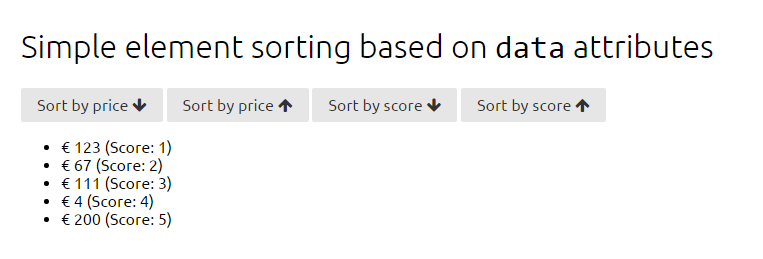

In the "jQuery.each()" method we're able to pass in an arbitrary array or object in which for each item will have the callback function executed. The "jQuery.each()" function however works differently from the $(selector).each() function that works on the DOM element using the selector. Other objects are iterated on their key-value properties. Array-like objects with a length property are iterated by their index position and value. The "j Query.each()" function is a general function that will loop through a collection (object type or array type). It starts with '.' followed by class nameįor more details read this article: Selectors in jQuery Question 5. Selects all elements with class as myclass. Let's say, $('.myclass').hide() will hide all elements with class as myclass with implicit looping.Īs we discussed earlier, $() accepts a string parameter having tag name or Element Id or class name as shown in the following table: Selector The methods called on $(), will implicitly be applied on all the elements returned by it without need of explicit looping. Always use jQuery in place of $, if you are using more than one JavaScript library to resolve conflicts with jQuery library. We can rewrite $(document).ready() as jQuery (document).ready(), since $ is an alias for jQuery. We created an anonymous function inside ready() function to hide div1. It won't wait for the images to load for executing the jQuery script.
#Jquery insert p element for each db item code#
$(document).ready() indicates that code in it needs to be executed once the DOM got loaded. $() will return zero or more DOM elements on which we can apply an effect or style. This is done with the help of $() construct with a string parameter containing any CSS selector expression. The basic operation in jQuery is selecting an element in DOM. What are selectors in jQuery and how many types of selectors are there? Before knowing a CDN and its usage, it is very important to understand this process: What and Why of CDN Question 4.

Now one may ask, how are requests served when a user enters a URL into the browser? Interesting, let's have a look at it. Static content is like CSS, images, JavaScript, flash files, video files and so on.

Dynamic content is the one that generally comes from a database. In other words, a CDN is a network of servers in which each request will go to the closest server.įor any web application, data can be categorized into either static or dynamic content. What is a CDN?Ĭontent Delivery Network (CDN) in simple terms is a collection of servers spread across the globe. Learn more here: JQuery No-Conflict And Using Different Versions Of jQuery Question 3. And in our development life, we are not at all strict to only jQuery. Also use the $ (Which is the default reference of jQuery) as a function or variable name what jQuery has. When we use jQuery no-conflict mode, we are replacing the $ to a new variable and assigning to jQuery some other JavaScript libraries. JQuery no-conflict is an option given by jQuery to overcome the conflicts between the different js frameworks or libraries. Expandable functionality using custom plugins.įor more follow the link: Introduction To jQuery Question 2.Hundreds of plugins for pre-built user interfaces, advanced animations, form validation, etc.In simple words jQuery has been designed to make navigation to any element easier, or adding/invoking event handlers on your HTML page and also simplify the way you access the elements in your web pages, provide help in working with client-side events, enable visual effects like animation, and make it easier to use Ajax in your applications.Ī quick look at what is available in jQuery: The on() method is not limited to form controls like buttons and inputs it can even attach handlers to paragraphs! $("h1,p,a").JQuery is a cross-browser lightweight JavaScript library. In earlier versions of jQuery, the $.fn.bind() method was employed it has since been deprecated (as of jQuery version 1.7) in favor of $.fn.on().
#Jquery insert p element for each db item how to#
In today’s blog, we’ll learn how to easily bind and remove event handlers using a little jQuery. Why would you want to do that? There may be a variety of reasons, form dynamic elements to efficient use of resources. Moreover, we can remove said handlers at will. Yuck! Today, we can bind numerous handlers to the same element event at any time. It was also limited to one and only one handler. It was not a great implementation for several reasons. Once upon a time, event handlers were bound to HTML elements using an inline “on” attribute.


 0 kommentar(er)
0 kommentar(er)
